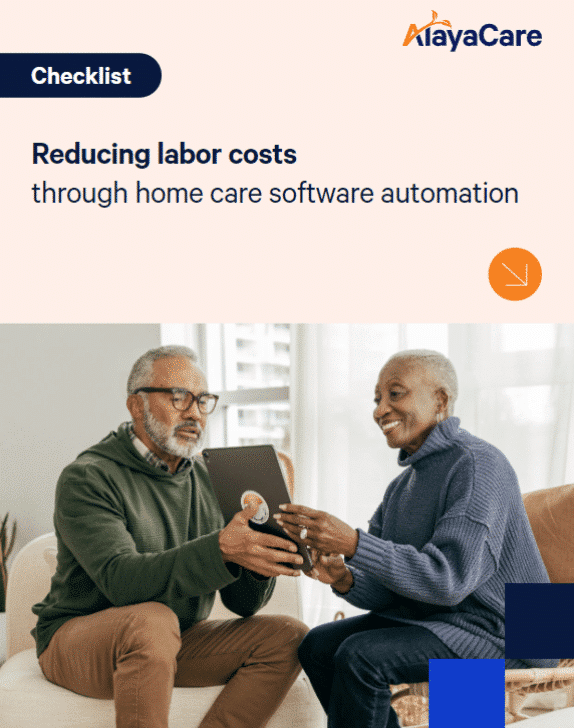Blog
Overcoming labor cost challenges in home care through automation

The home care industry in the United States plays a crucial role in supporting individuals who require assistance with daily activities while remaining in the comfort of their own homes. However, home care faces its fair share of challenges like any industry. One significant challenge that home care agencies must navigate is managing labor costs effectively. The rising demand for services, coupled with limited resources, has placed a strain on agencies across the country. Thankfully, the advent of automation in home care software presents a viable solution to address these challenges. In this blog, we’ll explore the impact of labor costs on the home care industry and how automation can alleviate these burdens leading to better outcomes.
3 Common challenges of labor costs in home care:
1. Administrative burden:
Home care agencies often grapple with extensive administrative tasks, such as documentation, billing, and scheduling. These tasks require significant time and effort from staff members, taking their focus away from providing direct care.
For instance, 57% of home care agencies reported that they spend up to 3 hours a day on administrative tasks. In addition, Helping Hands Orillia, a community and social support service, said they spent 50 hours a week on client calls taking time away from other key deliverables. More time spent on repetitive and manual tasks equals more money spent on administrators and caregivers performing these tedious tasks. The costs associated with employing additional administrative personnel to manage these tasks can also quickly accumulate. This can be straining on the agency’s financial resources.
2. Inefficient caregiver scheduling:
Optimizing caregiver schedules is crucial for efficient service delivery. However, manual scheduling processes can be time-consuming and prone to errors. According to a report by AlayaCare and HHCN on home care industry challenges, they found that home care providers reported that one of the main reasons for employee churn was inconsistent scheduling which results in additional costs.
About 64% turnover is reported by US home health care agencies, with over $4500 in costs to replace an employee.
Suboptimal schedules can result in wasted time and increased labor costs due to overtime and unnecessary travel. For example, if a caregiver is assigned to clients located far apart from each other, travel time and expenses can add up significantly – which is another concern for employee churn, according to providers in another survey report.
3. Timekeeping and verification:
Accurately tracking and verifying caregiver hours poses another challenge. Manual timekeeping methods, such as paper timesheets, are susceptible to inaccuracies and potentially fraudulent activities. Ensuring compliance with regulations and accurately billing clients can become cumbersome, leading to financial losses and potential legal complications.
Try automation as a solution
Automation tools are one solution to the challenges discussed. How? Home care software platforms have automation features powered by artificial intelligence and advanced algorithms to speed up tasks, perform tedious tasks for you, and simplify processes. Here are some examples of how these tools offered by software platforms can help you overcome labor cost challenges:
- Streamlining Administrative Tasks: Home care software platforms offer features such as electronic health records (EHRs), automated invoicing, and integrated scheduling. By digitizing and automating these administrative tasks, agencies can reduce paperwork, streamline documentation processes, and eliminate repetitive tasks. This allows your staff to focus on delivering quality care, minimizing the need for additional administrative personnel – saving you money in the long run.
- Optimizing Caregiver Scheduling: Home care software can provide dedicated scheduling modules that take into account caregiver availability, client needs, and geographical locations. Automation basically simplifies your scheduling process, ensuring your caregivers are assigned to the right clients at the right times. By optimizing schedules, agencies can reduce overtime costs, minimize travel time, and improve overall efficiency.
- Utilizing Electronic Visit Verification (EVV): Software platforms that offer EVV, automates the tracking and reporting of caregiver hours. With this, agencies can accurately verify caregiver visits, eliminating manual timesheets and reducing the risk of billing errors or fraud. This not only saves time but also ensures compliance with regulations, leading to cost savings and increased accountability.
- Embracing Telehealth Solutions: Telehealth platforms have become invaluable tools in the home care industry. These solutions enable virtual consultations, remote monitoring, and real-time communication with clients. By implementing telehealth, your organization can reduce travel expenses and optimize your caregivers’ time. Virtual appointments and remote monitoring allow for efficient care delivery, enabling your caregivers to attend to more clients in a given time frame ultimately lowering unnecessary labor costs.
- Using Mobile Caregiver Apps: Mobile caregiver apps empower caregivers with user-friendly tools and information. These apps can help streamline communication and improve task management, so your agency can reduce the time spent on non-care-related activities. This boosts caregiver productivity and ultimately reduces labor costs.
See how Helping Hands Orillia was able to reduce 50 hours a week on mundane tasks when they adopted automated workflows with Home Care software:
Labor cost challenges in the home care industry can place significant strains on agencies. However, with the implementation of automation through home care software, these challenges can be effectively addressed. By streamlining administrative tasks, optimizing caregiver scheduling, utilizing electronic visit verification, embracing telehealth solutions, and using mobile caregiver apps, your agency can:
- improve operational efficiency,
- reduce labor costs,
- and ultimately deliver better outcomes for both caregivers and clients.
Embracing automation in home care is the way forward, leading to a more sustainable and effective industry that meets the needs of those seeking quality care in their homes.
Download our free checklist Reducing Labor Costs Through Home Care Software Automation to get a head start on saving!



